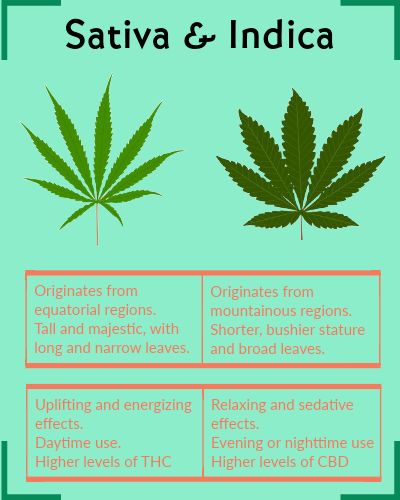Indica and Sativa difference, and the cannabis strains effects
In the world of cannabis, recreational and medical users often encounter the terms “Indica” and “Sativa.” These are two primary types of cannabis plants. The indica and sativa effects are poles apart as they have distinct characteristics and applications. Understanding the indica and sativa difference is crucial for those seeking specific therapeutic benefits or recreational experiences.
The Sativa cannabis strains have a towering stature and invigorating effects. They captivate cannabis enthusiasts seeking a lively and uplifting experience. The Sativa strains originated from equatorial regions. These have gained popularity for their capacity to boost creativity, enhance focus, and foster sociability. Sativa strains exemplify the diverse and dynamic nature of a particular cannabis variety.
Indica cannabis strains have a compact stature and calming effects. These strains enthrall cannabis users seeking relaxation and therapeutic benefits. Indica originated from the Hindu Kush region. It garnered popularity for inducing profound physical calmness, pain relief, and a characteristic “couch-lock” experience. Indica strain epitomize the serene and soothing nature of a particular cannabis variety.
The primary differences between Indica and Sativa cannabis strains lie in their physical characteristics, psychoactive effects, and potential medicinal uses. Here’s a breakdown of these distinctions:
Origins and Physical Traits
Indica strains originally hail from the Hindu Kush mountain range, which spans from Pakistan to Afghanistan. Indica cannabis plants boast distinctive physical traits, characterized by their shorter, bushier stature and broad leaves. Originating from mountainous regions, they have adapted to colder climates, featuring a shorter flowering period. The resulting plants are robust and well-suited for cultivation in environments where temperatures can be less forgiving.
Sativa strains, on the other hand, originated in equatorial regions such as Southeast Asia, Central and South America, and Africa. Sativa cannabis plants stand out with their unmistakable physical traits. Tall and majestic, they can reach heights of 12 feet or more under optimal growing conditions. Featuring long and narrow leaves, Sativa plants create an elegant appearance. They thrive in warmer climates and generally have a longer flowering period compared to Indica strains.
Psychoactive Effects
Indica strains are renowned for their relaxing and sedative effects on both the body and mind. The psychoactive profile of Indica strains often features higher levels of CBD (cannabidiol) compared to THC (tetrahydrocannabinol). The cannabinoids and terpenes in Indica strains often contribute to a sense of physical calmness, making them popular choices for evening or nighttime use. Many users have reported sensations of full-body relaxation, commonly referred to as the “couch-lock” effect.
Sativa strains are associated with more uplifting and energizing effects. They are distinguished by their invigorating and cerebral effects. These strains are often chosen for daytime use, as they tend to enhance creativity, focus, and sociability. This is based on a psychoactive profile often dominated by higher levels of THC. Sativa strains are less likely to induce sedation and preferred by people who want a cerebral and euphoric experience. It is also useful for social engagements and creative pursuits. Some users find Sativa strains to be helpful in managing mood disorders and fatigue.
Cannabinoid and Terpene Profiles
Indica strains typically have higher levels of the cannabinoid CBD (cannabidiol) compared to THC (tetrahydrocannabinol). CBD is known for its potential therapeutic benefits, including anti-inflammatory and anxiety-reducing properties. Additionally, Indica strains often contain higher concentrations of myrcene, a terpene associated with sedative effects.
Sativa strains, on the other hand, often have a higher THC to CBD ratio, resulting in more pronounced psychoactive effects. The terpene profile of Sativa strains may include terpinolene and limonene, contributing to their uplifting and mood-enhancing properties. These strains may be more suitable for individuals seeking relief from conditions such as depression or chronic fatigue.
Medicinal Uses
Due to their relaxing effects, Indica strains are frequently recommended for managing conditions such as chronic pain, muscle spasms, and insomnia. The anti-inflammatory properties of CBD in Indica strains may also make them beneficial for individuals dealing with arthritis or autoimmune disorders. Some cancer patients undergoing chemotherapy may find relief from nausea and appetite loss with the use of Indica strains.
Sativa strains can be valuable for individuals dealing with mood disorders like depression and anxiety. The energizing effects may help alleviate fatigue associated with conditions such as chronic fatigue syndrome. Additionally, some patients with attention disorders report improved focus and concentration with the use of Sativa strains.
Many cannabis strains are hybrids, combining characteristics and indica and sativa effects. Additionally, the effects of cannabis and the indica and sativa difference can vary widely based on factors such as individual tolerance, dosage, and consumption method. As the cannabis industry evolves, further research may reveal additional nuances and complexities in the interactions between cannabinoids and terpenes. Thus, we can get a better understanding of these two primary types of cannabis strains.
Noteworthy Indica and Sativa strains
Popular Indica Strains: Within the diverse realm of Indica strains, several varieties stand out, each offering unique flavors and effects. Some noteworthy Indica strains include:
- Granddaddy Purple: Renowned for its vibrant purple hues and grape-like aroma, Granddaddy Purple delivers a potent body high, inducing relaxation and euphoria.
- Northern Lights: A classic Indica strain, Northern Lights is celebrated for its soothing effects and earthy, sweet flavor profile, making it a favorite among cannabis connoisseurs.
- OG Kush: Known for its pungent aroma and powerful sedative effects, OG Kush is a staple in the Indica category, providing a deep sense of relaxation.
Popular Sativa Strains: Within the expansive realm of Sativa strains, numerous varieties stand out, each boasting unique flavor profiles and effects. Some noteworthy Sativa strains include:
- Sour Diesel: Renowned for its diesel-like aroma and potent, uplifting effects, Sour Diesel is a top choice for those seeking a creative boost.
- Jack Herer: Bearing the name of the legendary cannabis activist, Jack Herer delivers a blissful and clear-headed high, making it an ideal option for daytime use.
- Durban Poison: Originating from South Africa, Durban Poison is celebrated for its sweet and spicy aroma, coupled with an energetic and euphoric high.
Reach out to HerbNJoy for Indica and Sativa strains from well-known brands. HerbNJoy is a boutique cannabis dispensary with a unique in store shopping experience offering customers top cannabis strains at the lowest prices in the area.
We have stores in Los Angeles, San Diego and our Central Valley dispensary is in Hanford. Check out our deals for some exciting stuff.
In conclusion, the indica and sativa difference extend beyond mere botanical classifications. It is crucial to understand the indica and sativa effects, origins, physical traits, and potential medicinal uses. This will help you make an informed decision when selecting cannabis products. It’s essential to note that the effects of cannabis can vary widely from person to person, and many strains are hybrids that combine characteristics of both Indica and Sativa. As the cannabis industry continues to evolve, further research will provide deeper insights into the complexities of these remarkable plants.








